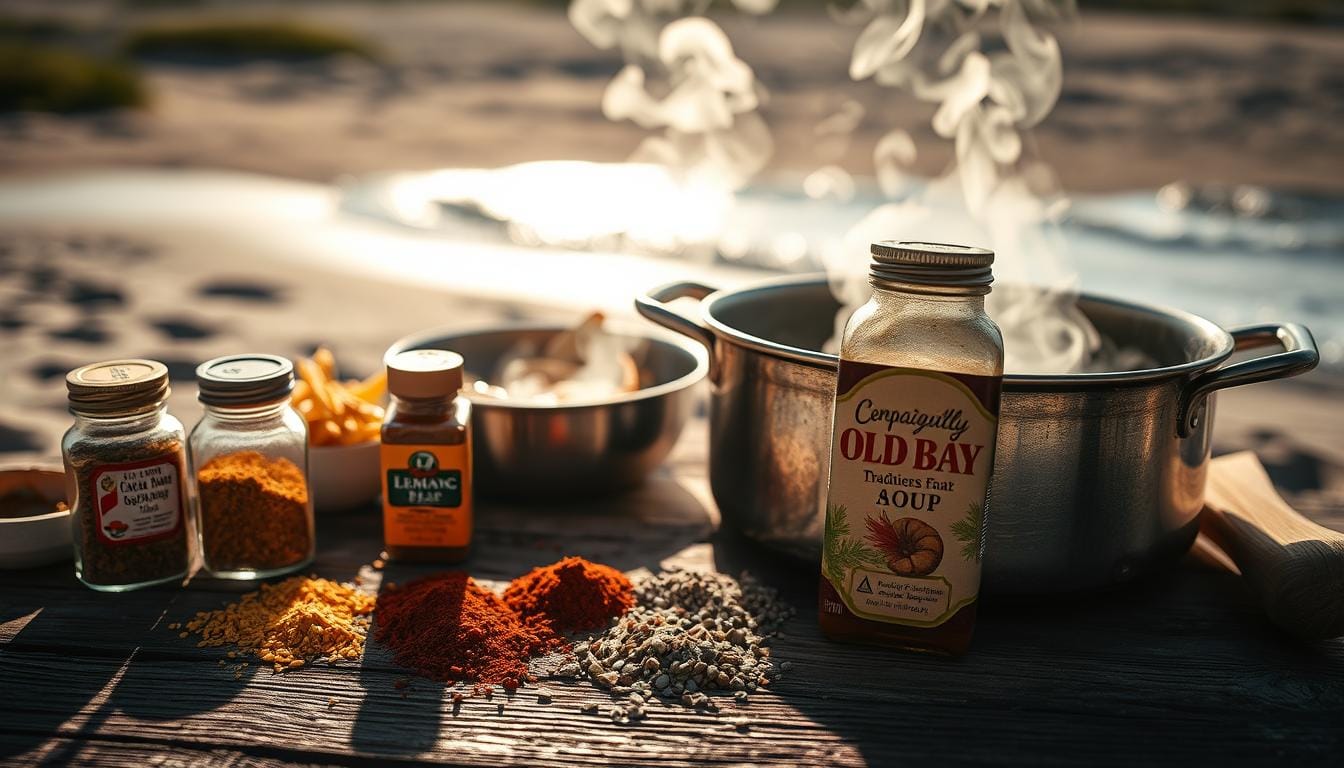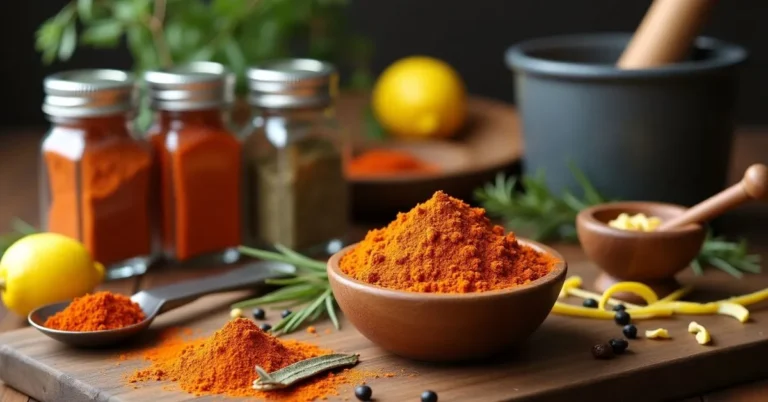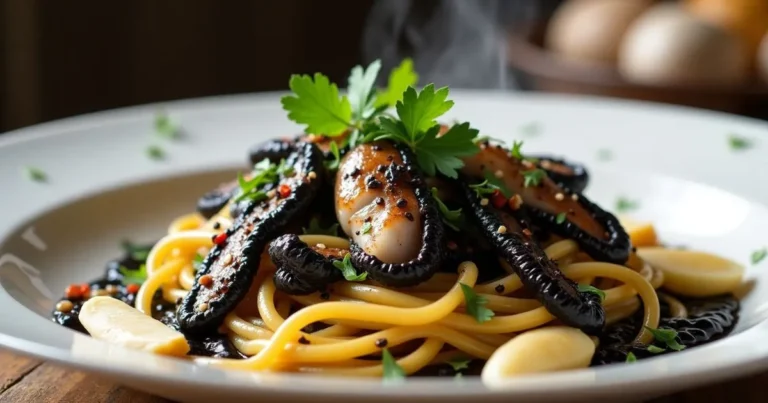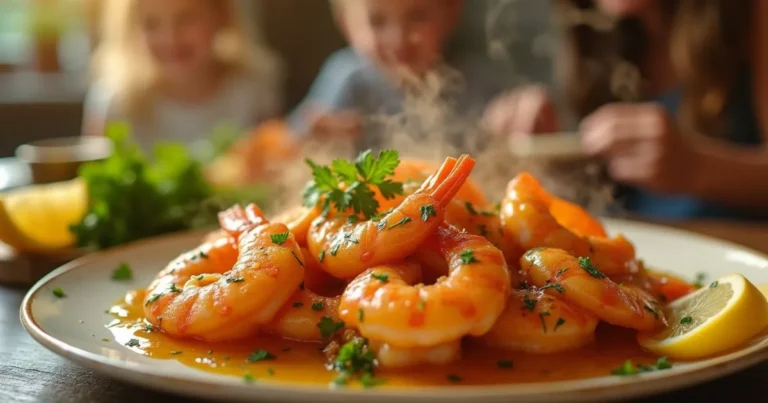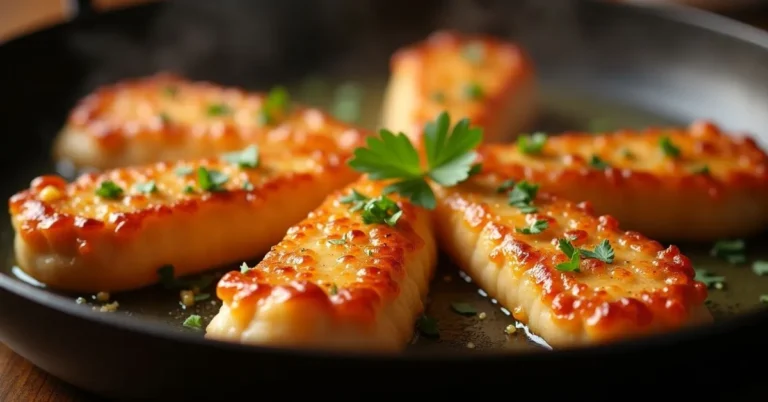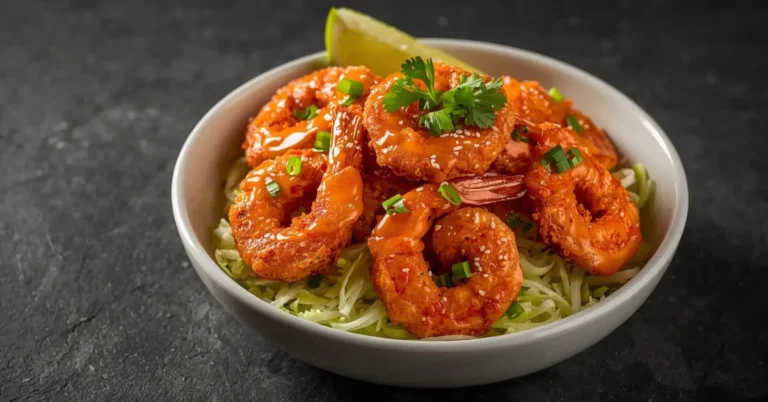How To Make tasty Seafood Boil Seasoning Recipe At Home

Growing up on the Gulf Coast, seafood boils were more than meals. They were family gatherings, filled with flavor and tradition. Every summer, our family would gather around big pots. They were steaming with fresh shrimp, crab, and crawfish.
Creating the perfect seafood boil seasoning recipe is more than mixing spices. It’s about making an experience. Your homemade seasoning can turn a simple dinner into a feast. It brings people together, capturing the essence of coastal cuisine.
The secret is understanding how flavors work together. Salt brings out sweetness, and umami adds depth. With the right seasoning, your seafood will sing.
Key Takeaways
- Seafood boil seasonings are a gateway to authentic coastal dining experiences
- Balanced spice blends transform ordinary seafood into extraordinary meals
- Homemade seasonings offer more flavor complexity than store-bought alternatives
- Understanding umami is crucial for creating depth in seafood dishes
- Regional variations can inspire unique seasoning approaches
Understanding the Art of Seafood Boil Seasoning
Seafood boil traditions are deep in coastal communities. They turn simple ingredients into amazing meals. Your journey into seafood seasoning blend reveals a rich cultural story.
Coastal cooking is more than food—it’s a celebration of community and flavor. Each cajun spice mix has a story of innovation and pride.
Origins of Coastal Cooking Traditions
Seafood boil seasonings come from cultural exchanges along coasts. Fishermen and locals created unique seasoning techniques. They aimed to:
- Preserve fresh catch
- Enhance natural seafood flavors
- Create memorable communal dining experiences
Role of Seasoning in Seafood Preparation
Seasoning is more than flavor—it’s an art form. A good seafood seasoning blend can make any dish special.
“Seasoning is the soul of cooking, the language through which ingredients speak.” – Anonymous Chef
Cultural Significance of Seafood Boils
Seafood boils are more than meals—they’re social events. The cajun spice mix connects people across generations.
| Region | Signature Seasoning Style | Key Ingredients |
|---|---|---|
| Louisiana | Cajun Spice Mix | Paprika, Cayenne, Garlic Powder |
| Maryland | Old Bay Seasoning | Celery Salt, Red Pepper, Black Pepper |
| Texas Gulf Coast | Tex-Mex Seafood Blend | Chili Powder, Cumin, Lime Zest |
Knowing these traditions shows the beauty of seafood boil seasonings. It’s a story of human creativity and culture.
Essential Ingredients for Perfect Seafood Boil Seasoning Recipe
Making the ultimate shrimp boil seasoning is all about mixing strong flavors. It turns your seafood feast into a memorable coastal culinary experience. Start by picking top-notch ingredients to make crab boil spices truly stand out.

- Unsalted butter (1 1/2 cups)
- Minced garlic (2 teaspoons)
- Fresh lemon juice
- Hot sauce (1/4 cup)
- Worcestershire sauce
- Smoked paprika (1 tablespoon)
- Onion powder
- Cayenne pepper (1 teaspoon)
- Kosher salt (2-3 tablespoons)
- Black pepper
Your seasoning mix should have heat, saltiness, and a rich aroma. Different areas might use different spice mixes. But these basic ingredients will make your seafood boil amazing every time.
“The secret to an incredible seafood boil is in the nuanced layering of flavors” – Gulf Coast Chef
When making your shrimp boil seasoning, think about the protein you’re cooking. Crab boil spices might need different amounts than shrimp seasonings. Try different ratios to find your ideal mix.
The Science Behind Umami in Seafood Seasonings
Umami is the magical fifth taste that makes seafood dishes special. It’s key to making old bay seasoning and crawfish boiling spices taste amazing.
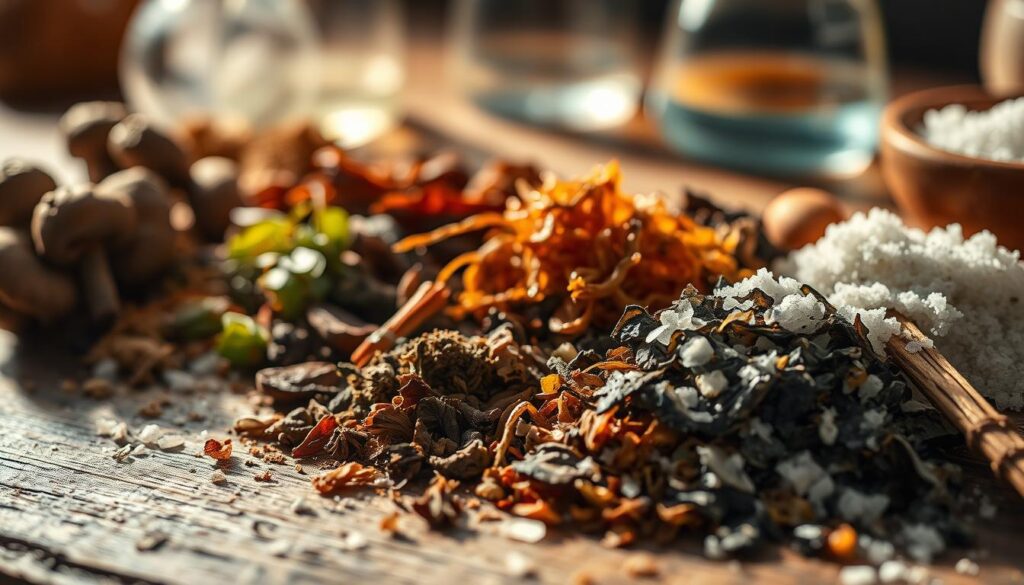
Seafood seasonings bring out deep, savory flavors. They use special ingredients that boost taste. The science of umami is about finding compounds that make flavors stronger.
Natural Umami Sources
Your seasoning blend can get deep flavor by using natural umami sources:
- Dried seaweed extracts
- Fish powder
- Fermented ingredients
- Aged cheese derivatives
Flavor Enhancement Techniques
Chefs and home cooks can make crawfish boiling spices better with certain methods:
- Toasting spices to release essential oils
- Combining complementary flavor profiles
- Balancing salt and acid levels
- Experimenting with fermentation processes
Balancing Taste Profiles
Making a perfect seasoning mix is all about balance. Old bay seasoning shows this by mixing sweet, salty, spicy, and umami flavors together.
By learning these tricks, you can turn your seafood dishes into something truly special. They’ll offer complex flavors that excite your taste buds.
Core Spices and Their Flavor Contributions
Making the perfect seafood boil seasoning recipe is all about the spices. Your cajun spice mix is like a symphony that turns simple seafood into a feast to remember.
The main spices in a great seafood seasoning are:
- Paprika: Gives a sweet and smoky flavor
- Garlic powder: Adds a deep, aromatic taste
- Onion powder: Adds a subtle sweetness and depth
- Black pepper: Brings sharp, warming heat
- Cayenne pepper: Adds a spicy kick
Each spice is important in your seafood boil seasoning. Paprika comes in sweet and smoked types. Sweet paprika adds a mild, fruity taste. Smoked paprika brings a rich, campfire-like flavor that makes the dish stand out.
Getting the spice balance right is key. Start with small amounts of strong spices like cayenne. Then, adjust to your liking. Try adding herbs like celery seed or mustard powder for extra depth. This will make your seafood boil unforgettable.
Pro tip: Always taste and adjust your spice blend before the final mix – your palate is the ultimate judge!
Fresh vs. Dried Herbs in Seafood Seasonings
Creating the perfect homemade seasoning for seafood boils is all about knowing the difference between fresh and dried herbs. The right mix can turn your seafood seasoning blend from good to great.
When making your seafood seasoning blend, it’s key to know the strengths of fresh and dried herbs. Fresh herbs bring bright, intense flavors that can make your seafood boil stand out. Herbs like parsley, thyme, and basil are at their best when fresh.
Storage and Preservation
Dried herbs have big advantages when it comes to storage and lasting power. Your homemade seasoning can stay potent for 8-10 months if stored right. Here are some tips:
- Keep herbs in airtight containers
- Store in cool, dark places
- Avoid direct sunlight and moisture
- Label containers with purchase or preparation dates
Seasonal Availability
Seasonal changes affect herb availability and quality. In winter, dried herbs are key for keeping flavors consistent in your seafood seasoning blend.
Flavor Intensity Comparison
Knowing how potent herbs are helps you make balanced seasonings. Generally, one tablespoon of dried herbs is like three tablespoons of fresh herbs. This helps your seafood boil stay flavorful, no matter the herb.
Try different mixes to find your ideal seafood seasoning blend. The right mix of fresh and dried herbs can elevate your seafood boil to a culinary masterpiece.
Secret Ingredients for Enhanced Umami
To make your shrimp boil seasoning better, learn about umami ingredients. These special flavor boosters can turn a simple crab boil into a memorable dish.
Looking for unique umami boosters can really make your seafood seasoning better. Some surprising ingredients can add amazing depth to your dish:
- Dried mushroom powder
- Nutritional yeast
- Small quantities of fish sauce
- Kelp powder
- Nori flakes
Professional chefs say to use fermented ingredients carefully. Miso paste and Worcestershire sauce can add a lot of flavor, but use them sparingly.
| Ingredient | Umami Impact | Recommended Quantity |
|---|---|---|
| Oyster Sauce | Intense umami flavor | 1-2 tablespoons |
| Dried Mushroom Powder | Deep earthy notes | 1 teaspoon |
| Nutritional Yeast | Nutty undertones | 2 tablespoons |
When trying these secret ingredients, start with a little. You want to add to the flavor, not take over. Each addition should blend well with your shrimp boil seasoning.
Pro tip: Always taste and adjust your crab boil spices blend incrementally to achieve the perfect umami balance.
Customizing Heat Levels in Your Blend
Making the perfect cajun spice mix is all about finding the right balance. You can go from mild to wild with the right peppers and the right amount.
Knowing about different peppers is key to making your seasoning blend just right. Each pepper has its own heat level, which can change your seafood boil a lot.
Pepper Heat Scale Breakdown
Choosing the right peppers lets you control how spicy your seasoning is. Here’s a guide to help you pick the right pepper heat:
- Bell Peppers: Zero heat, pure flavor
- Poblano: Mild, slightly warm sensation
- Jalapeño: Medium heat kick
- Cayenne: Significant spice level
- Habanero: Intense, fiery experience
- Ghost Pepper: Extreme heat challenge
Regional Heat Variation Techniques
Every region has its own way of adding heat to cajun spice mix. Southern Louisiana likes it hot, while New England prefers it milder.
| Region | Heat Preference | Typical Pepper Used |
|---|---|---|
| Louisiana | High | Cayenne, Habanero |
| Texas Gulf Coast | Medium-High | Jalapeño, Serrano |
| New England | Low | Paprika, Black Pepper |
Heat Customization Tips
When making your crawfish boiling spices, start with a little hot pepper. It’s easier to add more heat than it is to take it away. Taste and adjust slowly to get your spice just right.
Pro tip: Use dried pepper flakes for consistent heat distribution in your seasoning blend.
Measuring and Mixing Techniques
Making the perfect homemade seasoning for seafood boils needs precision and careful technique. Your seafood boil seasoning recipe requires attention to detail from the start to the end.
Professional chefs suggest several key methods for a great seasoning blend:
- Use digital kitchen scales for precise ingredient measurements
- Invest in high-quality spice grinders for consistent texture
- Toast whole spices before grinding to enhance flavor profiles
- Sift ground spices to eliminate potential clumping
When making your homemade seasoning for seafood boils, follow this mixing strategy:
- Start with dried spices as your base
- Gradually incorporate salt and heat elements
- Mix thoroughly to ensure even distribution
- Store in airtight containers to maintain freshness
The best mixing technique is to layer flavors. Start with milder spices and add more intense ones gradually. This way, each spice adds its unique flavor to the final seasoning.
| Spice Category | Recommended Proportion | Mixing Order |
|---|---|---|
| Dried Herbs | 20% | First Layer |
| Salt Blend | 30% | Second Layer |
| Pepper Varieties | 25% | Third Layer |
| Intense Spices | 25% | Final Layer |
Creating the perfect seafood boil seasoning is an art. Practice, taste, and adjust your recipe until it’s just right for your seafood dishes.
Storage Solutions for Homemade Seasonings
Keeping your homemade seafood seasoning blend fresh is key. Whether it’s old bay seasoning or a custom mix, the right storage keeps flavors alive.
Storing your seafood seasoning blend right is crucial. The right container and conditions can make it last longer.
Optimal Container Selection
Look for containers that meet these needs:
- Airtight seal to keep moisture out
- Dark glass or opaque containers
- Non-reactive materials like glass or ceramic
- Size that fits your seasoning amount
Environmental Preservation Factors
Your homemade old bay seasoning does best in certain conditions. Keep it in a cool, dark spot, away from sunlight and heat.
| Storage Condition | Impact on Seasoning |
|---|---|
| Temperature | Below 70°F (21°C) recommended |
| Humidity | Less than 50% preferred |
| Light Exposure | Minimal to none |
| Expected Shelf Life | 6-12 months when stored properly |
Always mark your seafood seasoning blend with the date you made it. This helps you know when it’s freshest and use the best in your cooking.
Pairing Your Seasoning with Different Seafood Types
Creating the perfect shrimp boil seasoning means knowing how different seafood tastes. Each seafood needs a special touch to bring out its flavor without covering it up.
When making your crab boil spices, keep these tips in mind:
- Delicate white fish needs light, subtle seasonings
- Strong shellfish can handle bold spice mixes
- Think about the cooking method when picking your spices
Seafood reacts differently to seasonings. Shrimp soaks up flavors fast, while lobster needs a gentle hand. Your seasoning plan should match each seafood’s unique needs.
| Seafood Type | Recommended Seasoning Intensity | Cooking Time |
|---|---|---|
| Shrimp | Medium-High | 6-8 minutes |
| Crab | High | 6-8 minutes |
| Lobster Tails | Low-Medium | 6-8 minutes |
| Crawfish | High | 5-7 minutes |
Pro tip: Always taste and adjust your seasoning as you cook. A bit of celery salt or cayenne can make your seafood boil amazing.
The secret is balancing your spices to complement, not compete with, the seafood’s natural flavors.
Incorporating Asian Fusion Elements
Take your seafood boil seasoning to new heights by diving into Asian flavors. These flavors can turn a simple seafood boil into a memorable meal. They add depth and complexity to your seafood dishes.
Asian spices can greatly improve your seafood seasoning blend. By adding unique ingredients, you can create amazing flavor profiles. These ingredients bring subtle yet impactful changes to your cooking.
Traditional Asian Spices for Seafood
- Five-spice powder: A mix of star anise, cloves, cinnamon, Sichuan pepper, and fennel seeds
- Lemongrass: Adds a citrusy, aromatic taste
- Fresh ginger: Brings warmth and zesty flavors
- Dried shiitake mushrooms: Offers intense umami
Modern Fusion Approaches
Introducing Asian-inspired ingredients can revolutionize your seafood boil seasoning. Try adding oyster sauce for a rich, savory taste. It enhances seafood’s natural flavors without overpowering them.
Pro tip: Lee Kum Kee oyster sauce, with oysters as its first ingredient, adds incredible depth of flavor.
Be adventurous with your seafood seasoning blend. Mix in Thai lemongrass or Japanese miso seasonings. These unique combinations can make your seasoning blend stand out from the usual recipes.
- Thai fusion: Kaffir lime leaves, galangal, chili
- Japanese inspiration: Bonito flakes, seaweed, miso paste
- Chinese influences: Soy sauce, star anise, Shaoxing wine
For Asian fusion success, balance is key. Begin with small amounts of these strong flavors. Then, adjust them to achieve a seafood boil seasoning that pleases your taste buds.
Scaling Recipes for Large Gatherings
Planning a big seafood boil means you need to get your seasoning right. Scaling up your cajun spice mix is more than just multiplying ingredients. It’s about keeping the flavors balanced.
For large gatherings, follow these scaling tips:
- Calculate ingredient quantities based on guest count
- Use precise measuring tools for consistent seasoning
- Create concentrated seasoning blends
- Test small batches before large-scale preparation
For a seafood boil for 10 people, you’ll need:
| Ingredient | Quantity |
|---|---|
| Shrimp | 3.5 pounds |
| Corn | 8 cobs |
| Potatoes | 30 small red potatoes |
| Sausage | 20 ounces |
Pro tip: When scaling your cajun spice mix, always mix dry ingredients thoroughly. This ensures even seasoning. Large batches need extra care to avoid clumps and uneven flavor.
Don’t forget to adjust cooking times and use bigger pots. Your guests will love the consistent, tasty flavors!
Troubleshooting Common Seasoning Issues
Making the perfect seafood boil seasoning can be hard. Even seasoned cooks face problems. Knowing how to fix seasoning issues can make your seafood feast a hit.
Common seasoning problems include:
- Over-salting: A common mistake that can spoil your dish
- Unbalanced heat levels
- Lack of flavor depth
- Seasoning clumping or moisture absorption
To fix over-salting in your seafood boil seasoning, try these tips:
- Add more unseasoned ingredients to cut down salt
- Use lemon juice to balance out saltiness
- Starchy ingredients like potatoes can soak up extra salt
When using crawfish boiling spices, start with small amounts. Spices like paprika, cayenne, and black pepper can overpower. Taste and adjust slowly to build rich flavors.
Storing your seasoning is key to keeping it fresh. Store your seafood boil spices in airtight containers, away from heat and moisture. This prevents clumping and keeps your blend strong.
Pro tip: Fresh herbs can save an under-seasoned boil with their bright flavor. Dried spices offer consistent taste, while fresh ingredients add vibrant notes that enhance your seafood feast.
Conclusion
Your seafood boil seasoning recipe is more than just spices. It’s a way to enjoy unforgettable coastal meals. By making your own seasoning, you can turn simple ingredients into amazing dishes. The secret is finding the right mix of spices, like smoky paprika and zesty cayenne pepper.
Every seafood boil has its own story. It’s about tradition, creativity, and sharing with others. Whether you’re making a classic Louisiana-style meal or trying new flavors, your seasoning can make it special. The trick is to mix flavors well, so they enhance the taste of shrimp, crab, and more.
Creating the perfect seafood boil seasoning is all about being creative. Feel free to try new spice mixes, adjust the heat, and explore different flavors. Your unique blend can become a favorite dish that brings people together. It turns a simple meal into a special celebration of coastal food.
Start your culinary adventure today. Your seafood boil is not just a meal; it’s a way to connect with cooking traditions and show off your creativity. Begin mixing, cooking, and enjoying the tasty results of your seasoning journey.
FAQ
What is a seafood boil seasoning?
A seafood boil seasoning is a mix of spices and herbs. It’s made to make seafood taste better when cooked. It usually has salt, peppers, dried herbs, and spices that make shrimp, crab, and crawfish taste great.
How long can I store homemade seafood boil seasoning?
Homemade seafood boil seasoning can last 3-6 months if stored right. Keep it in an airtight container in a cool, dark place. Make sure it’s away from moisture, sunlight, and heat. Always check it before using to see if it’s still good.
Can I adjust the heat level in my seafood boil seasoning?
Yes, you can change the heat level to your liking. Start with a little cayenne pepper or red pepper flakes. You can always add more to make it spicier. The Scoville scale can help you pick the right peppers.
What are the essential spices for a basic seafood boil seasoning?
The basic spices are paprika, garlic powder, onion powder, black pepper, and cayenne pepper. You can also add celery seed, mustard powder, and dried herbs. The goal is to find a mix that brings out the seafood’s natural taste.
How do I make my seafood boil seasoning more umami-rich?
To make it more umami, add dried mushroom powder, nutritional yeast, a bit of fish sauce, or kelp powder. These ingredients will deepen the flavor of your seafood seasoning.
Can I use the same seasoning for different types of seafood?
While you can make a versatile blend, it’s better to adjust it for each seafood type. Delicate fish might need a lighter seasoning, while shellfish like crawfish can handle stronger flavors. Think about the seafood’s natural taste when mixing your blend.
Are there any low-sodium options for seafood boil seasoning?
Yes, you can make a low-sodium version. Use less salt and add citrus zest, dried herbs, and spices instead. Start with a salt-free blend and add your favorite herbs and spices to keep the flavor strong without the salt.
How can I store my seafood boil seasoning to maintain its freshness?
Store it in an airtight container, like glass or ceramic, with a tight lid. Keep it in a cool, dark place, away from sunlight and heat. Don’t store it near the stove or in humid places. Vacuum-sealed bags are great for longer storage.
Can I create an Asian-inspired seafood boil seasoning?
Definitely! Add Asian flavors like five-spice powder, lemongrass, ginger, dried shiitake mushrooms, or nori flakes. You can mix traditional seafood boil spices with Asian ingredients for a unique taste.

